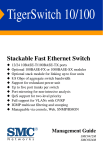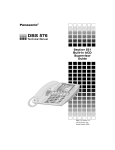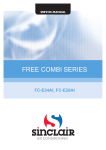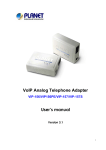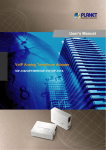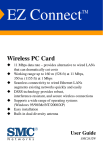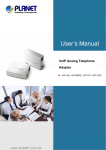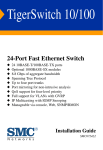Download SMC (SMC8500GT) Expansion Module
Transcript
SMC8506T 10/100/1000 Gigabit Copper Switch • • • • • 6 10/100/1000 RJ-45 Ports with 1 expansion bay 2 port 1000Base-TX or 2 port 1000SX modules Auto MDI/MDIX on all ports Half- and full-duplex flow control "Smart Function" features: 9 24K MAC Address Table 9 Port-based VLAN and L2 Trunking 9 Password Authentification 9 Port Mirroring 9 Desktop and rack mountable Installation Guide SMC8506T EZ Switch 1000 User Guide From SMC’s EZ line of low-cost workgroup LAN solutions 6 Hughes Irvine, CA 92618 Phone: (949) 707-2400 Copyright Information furnished by SMC Networks, Inc. (SMC) is believed to be accurate and reliable. However, no responsibility is assumed by SMC for its use, nor for any infringements of patents or other rights of third parties which may result from its use. No license is granted by implication or otherwise under any patent or patent rights of SMC. SMC reserves the right to change specifications at any time without notice. Copyright © 2001 by SMC Networks, Inc. 6 Hughes, Irvine, CA. All rights reserved. Printed in Taiwan Trademarks: SMC is a registered trademark; and EZ Switch is a trademark of SMC Networks, Inc. Other product and company names are trademarks or registered trademarks of their respective holders. Limited Warranty Limited Warranty Statement: SMC Networks, Inc. (“SMC”) warrants its products to be free from defects in workmanship and materials, under normal use and service, for the applicable warranty term. All SMC products carry a standard 90-day limited warranty from the date of purchase from SMC or its Authorized Reseller. SMC may, at its own discretion, repair or replace any product not operating as warranted with a similar or functionally equivalent product, during the applicable warranty term. SMC will endeavor to repair or replace any product returned under warranty within 30 days of receipt of the product. The standard limited warranty can be upgraded to a Limited Lifetime* warranty by registering new products within 30 days of purchase from SMC or its Authorized Reseller. Registration can be accomplished via the enclosed product registration card or online via the SMC web site. Failure to register will not affect the standard limited warranty. The Limited Lifetime warranty covers a product during the Life of that Product, which is defined as the period of time during which the product is an “Active” SMC product. A product is considered to be “Active” while it is listed on the current SMC price list. As new technologies emerge, older technologies become obsolete and SMC will, at its discretion, replace an older product in its product line with one that incorporates these newer technologies. At that point, the obsolete product is discontinued and is no longer an “Active” SMC product. A list of discontinued products with their respective dates of discontinuance can be found at http://www.smc.com/smc/pages_html/support.html. All products that are replaced become the property of SMC. Replacement products may be either new or reconditioned. Any replaced or repaired product carries either a 30-day limited warranty or the remainder of the initial warranty, whichever is longer. SMC is not responsible for any custom software or firmware, configuration information, or memory data of Customer contained in, stored on, or integrated with any products returned to SMC pursuant to any warranty. Products returned to SMC should have any customer-installed accessory or add-on components, such as expansion modules, removed prior to returning the product for replacement. SMC is not responsible for these items if they are returned with the product. Customers must contact SMC for a Return Material Authorization number prior to returning any product to SMC. Proof of purchase may be required. Any product returned to SMC without a valid Return Material Authorization (RMA) number clearly marked on the outside of the package will be returned to customer at customer’s expense. For warranty claims within North America, please call our toll-free customer support number at (800) 762-4968. Customers are responsible for all shipping charges from their facility to SMC. SMC is responsible for return shipping charges from SMC to customer. WARRANTIES EXCLUSIVE: IF AN SMC PRODUCT DOES NOT OPERATE AS WARRANTED ABOVE, CUSTOMER’S SOLE REMEDY SHALL BE REPAIR OR REPLACEMENT OF THE PRODUCT IN QUESTION, AT SMC’S OPTION. THE FOREGOING WARRANTIES AND REMEDIES ARE EXCLUSIVE AND ARE IN LIEU OF ALL OTHER WARRANTIES OR CONDITIONS, EXPRESS OR IMPLIED, EITHER IN FACT OR BY OPERATION OF LAW, STATUTORY OR OTHERWISE, INCLUDING WARRANTIES OR CONDITIONS OF MERCHANTABILITY AND FITNESS FOR A PARTICULAR PURPOSE. SMC NEITHER ASSUMES NOR AUTHORIZES ANY OTHER PERSON TO ASSUME FOR IT ANY OTHER LIABILITY IN CONNECTION WITH THE SALE, INSTALLATION, MAINTENANCE OR USE OF ITS PRODUCTS. SMC SHALL NOT BE LIABLE UNDER THIS WARRANTY IF ITS TESTING AND EXAMINATION DISCLOSE THE ALLEGED DEFECT IN THE PRODUCT DOES NOT EXIST OR WAS CAUSED BY CUSTOMER'S OR ANY THIRD PERSON'S MISUSE, NEGLECT, LIMITED WARRANTY IMPROPER INSTALLATION OR TESTING, UNAUTHORIZED ATTEMPTS TO REPAIR, OR ANY OTHER CAUSE BEYOND THE RANGE OF THE INTENDED USE, OR BY ACCIDENT, FIRE, LIGHTNING, OR OTHER HAZARD. LIMITATION OF LIABILITY: IN NO EVENT, WHETHER BASED IN CONTRACT OR TORT (INCLUDING NEGLIGENCE), SHALL SMC BE LIABLE FOR INCIDENTAL, CONSEQUENTIAL, INDIRECT, SPECIAL, OR PUNITIVE DAMAGES OF ANY KIND, OR FOR LOSS OF REVENUE, LOSS OF BUSINESS, OR OTHER FINANCIAL LOSS ARISING OUT OF OR IN CONNECTION WITH THE SALE, INSTALLATION, MAINTENANCE, USE, PERFORMANCE, FAILURE, OR INTERRUPTION OF ITS PRODUCTS, EVEN IF SMC OR ITS AUTHORIZED RESELLER HAS BEEN ADVISED OF THE POSSIBILITY OF SUCH DAMAGES. SOME STATES DO NOT ALLOW THE EXCLUSION OF IMPLIED WARRANTIES OR THE LIMITATION OF INCIDENTAL OR CONSEQUENTIAL DAMAGES FOR CONSUMER PRODUCTS, SO THE ABOVE LIMITATIONS AND EXCLUSIONS MAY NOT APPLY TO YOU. THIS WARRANTY GIVES YOU SPECIFIC LEGAL RIGHTS, WHICH MAY VARY FROM STATE TO STATE. NOTHING IN THIS WARRANTY SHALL BE TAKEN TO AFFECT YOUR STATUTORY RIGHTS. * SMC will provide warranty service for one year following discontinuance from the active SMC price list. Under the limited lifetime warranty, internal and external power supplies, fans, and cables are covered by a standard one-year warranty from date of purchase. SMC Networks, Inc. 6 Hughes Irvine, CA 92618 The information in this manual is subject to change without notice. All the brand names are registered trademarks of their respective companies. COMPLIANCES FCC Class A This equipment has been tested and found to comply with the limits for a Class A digital device pursuant to Part 15 of FCC Rules. These limits are designed to provide reasonable protection against harmful interference when the equipment is operated in commercial environment. This equipment generates, uses, and can radiate radio frequency energy, and if not installed and used in accordance with the instruction manual may cause harmful interference to radio communications. Its operation in a residential area is likely to cause harmful interference in which case the user will be required to correct the interference at his own expense. EC Conformance Declaration - Class A SMC contact for these products in Europe is: SMC Networks Europe, Edificio Conata II, Calle Fructuós Gelabert 6-8, 2o, 4a, 08970 - Sant Joan Despí, Barcelona, Spain. This information technology equipment complies with the requirements of the Low Voltage Directive 73/23/EEC and the EMC Directive 89/336/EEC, and carries the CE Mark accordingly. It conforms to the following specifications: EMC: EN55024 (1998)/CISPR-22 (1995) Class A IEC 61000-4-2 (1995) 4 kV CD, 8 kV AD IEC 61000-4-3 (1995) 3 V/m IEC 61000-4-4 (1995) 1.0 kV - (power line) 0.5 kV - (signal line) IEC 61000-4-5 (1995) 2 kV - (line to line) 1 kV - (line to ground) IEC 61000-4-6 (1995) 3 Vrms IEC 61000-4-11 (1995) Voltage dip >95% - 10 ms 30% - 500 ms 60% - 100 ms Voltage interruption >95% - 5000 ms COMPLIANCES Industry Canada - Class A This digital apparatus does not exceed the Class A limits for radio noise emissions from digital apparatus as set out in the interferencecausing equipment standard entitled “Digital Apparatus”, ICES-003 of Industry Canada. Cet appareil numérique respecte les limites de bruits radioélectriques applicables aux appareils numériques de Classe A prescrites dans la norme sur le matérial brouilleur: “Appareils Numériques”, NMB-003 édictée par l’Industrie. Safety Compliance CSA/NRTL (C22.2.950, UL 1950) EN 60950, (IEC 950) Wichtige Sicherheitshinweise (Germany) 1. Bitte lesen Sie diese Hinweise sorgfältig durch. 2. Heben Sie diese Anleitung für den späteren Gebrauch auf. 3. Vor jedem Reinigen ist das Gerät vom Stromnetz zu trennen. Verwenden Sie keine Flüssigoder Aerosolreiniger. Am besten eignet sich ein angefeuchtetes Tuch zur Reinigung. 4. Die Netzanschlu ßsteckdose soll nahe dem Gerät angebracht und leicht zugänglich sein. 5. Das Gerät ist vor Feuchtigkeit zu schützen. 6. Bei der Aufstellung des Gerätes ist auf sicheren Stand zu achten. Ein Kippen oder Fallen könnte Beschädigungen hervorrufen. 7. Die Belüftungsöffnungen dienen der Luftzirkulation, die das Gerät vor Überhitzung schützt. Sorgen Sie dafür, daß diese Öffnungen nicht abgedeckt werden. 8. Beachten Sie beim Anschluß an das Stromnetz die Anschlußwerte. 9. Verlegen Sie die Netzanschlußleitung so, daß niemand darüber fallen kann. Es sollte auch nichts auf der Leitung abgestellt werden. 10. Alle Hinweise und Warnungen, die sich am Gerät befinden, sind zu beachten. 11. Wird das Gerät über einen längeren Zeitraum nicht benutzt, sollten Sie es vom Stromnetz trennen. Somit wird im Falle einer Überspannung eine Beschädigung vermieden. 12. Durch die Lüftungsöffnungen dürfen niemals Gegenstände oder Flüssigkeiten in das Gerät gelangen. Dies könnte einen Brand bzw. elektrischen Schlag auslösen. 13. Öffnen sie niemals das Gerät. Das Gerät darf aus Gründen der elektrischen Sicherheit nur von authorisiertem Servicepersonal geöffnet werden. 14. Wenn folgende Situationen auftreten ist das Gerät vom Stromnetz zu trennen und von einer qualifizierten Servicestelle zu überprüfen: a. Netzkabel oder Netzstecker sind beschädigt. b. Flüssigkeit ist in das Gerät eingedrungen. c. Das Gerät war Feuchtigkeit ausgesetzt. d. Wenn das Gerät nicht der Bedienungsanleitung entsprechend funktioniert oder Sie mit Hilfe dieser Anleitung keine Verbesserung erzielen. e. Das Gerät ist gefallen und/oder das Gehäuse ist beschädigt. f. Wenn das Gerät deutliche Anzeichen eines Defektes aufweist. 15. Zum Netzanschluß dieses Gerätes ist eine geprüfte Leitung zu verwenden. Für einen Nennstrom bis 6 A und einem Gerätegewicht größer 3 kg ist eine Leitung nicht leichter als H05VV-F, 3G, 0.75 mm2 einzusetzen. Der arbeitsplatzbezogene Schalldruckpegel nach DIN 45 635 Teil 1000 beträgt 70 dB(A) oder weniger. TABLE OF CONTENTS Chapter 1 Introduction - Features and Benefits Hardware Description Optional Modules Chapter 2 Equipment Checklist Selecting a site Positioning the switch Sample Applications Switch Operation Chapter 3 Configuring the Chapter 4 - SMC8506T Main Menu Port Setting VLAN Trunking Aging Function Control Port Enable/Disable Port Mirroring Port-based Priority MAC Address Filtering Password Enable/Disable Restoring Factory Default Glossary Chapter 1 Introduction - EZ Switch 1000 The SMC family of EZ Switch 1000 Gigabit Ethernet Switches (SMC8504T & SMC8506T) is the perfect solution for bottlenecks at the core of a network. Bottlenecks are the inevitable result of dataintensive applications and the proliferation of new users. SMC ’s EZ Switch 1000 provides a seamless migration to higher-speed networking while solving bandwidth issues. It is designed to allow simultaneous transmission of multiple packets via an internal highspeed data channel. In addition, the SMC8506T is also support one module slot for 2 Ethernet Gigabit ports to uplink to a server or network backbone. These gigabit switches are designed for Plug and Play installation, allows the network administrator to simply connect the network and power cables and the Switching/bridging functions begin automatically. Features and Benefits The SMC EZ Switch™ 1000 gigabit switch is based on advanced chip designs to maximize throughput and increase the efficiency of your network. It features all standards-based technology, built at leading edge manufacturing facilities for reliability; hence, SMC backs your new product with a Limited Lifetime Warranty. • • • • • • Auto MDI/MDI-X on each port to simplify integration into a network Complies with the IEEE802.3, IEEE802.3u, IEEE802.3z and IEEE802.3ab/ Gigabit Ethernet standard Provide a module slot for 2-port 10/100/1000Mbps-TX or 1000Mbps-SX options Features Store-and-Forward mode with wire-speed filtering and forwarding rates Each port can be configured to 10/100Mbps half or fullduplex, or to 1000Mbps full-duplex mode Automatic Source Address Learning and Aging to ensure • superior delivery of data. IEEE802.3x compliant full-duplex flow control, HOL blocking prevention Broadcast storm control, runt and CRC Filtering eliminates • • erroneous packets to optimize the network bandwidth Support to handle Jumbo Packets up to 1536 bytes packet LED indicators for simple diagnostics and management • • • • A reset switch is located on the front panel for easy access Internal power supply Advanced functions include: 1. RS-232 and Console port for changing port configurations 2. Port-base VLAN (not support port-base VLAN overlap) 3. Tagged-base QOS (not support port-base QOS) 4. Trunking 5. Port Mirroring 6. Per port Aging Function setting Hardware Description This section describes the hardware features of these Giga Switches. For easier management and control of the switch, familiarize yourself with its display indicators, and ports. Front panel illustrations in this chapter display the unit LED indicators. Before connecting any network device to the hub, read this chapter carefully Front Panel and LEDs LED Function Color Description PWR Green Lit: Power on SMART Green Lit: CPU initialization completed 10/100 Green/ Green Lit: 100Mbps, indicates the adapter is L10/100/1000 Yellow connected to hub and incoming (TX Module) Yellow Flash: 10Mbps, traffic entering the port 10/100 Green Lit: indicate link status and traffic speed L10/100/1000 (10/ L10 for 10M, 100/ L100 for 100M, 1000/ L1000 for 1000M) TX/ RX Green Lit: indicate data traffic status (TX for transmitting, RX for receiving) FDX/ COL Green Lit: Full-Duplex Flash: Half-Duplex/ Collision Off: Half-duplex or not connected Rear Panel The rear panel of the SMC8506T has an AC inlet power socket, which accepts input power from 100 to 240VAC, 5060Hz. And an RS-232 console port for setting up your new SMC8506T via a connection to a console terminal or PC using a terminal emulation program Also shown in the diagram below are two fans for cooling the unit. 100-240VAC 50-60Hz CONSOLE RS232 19200,N,8,1 Rear panel of SMC8506T Optional Modules There are two optional modules; a 2-port 1000BASE-T and a 2-port 100BASE-FX. These are shown, in that order, in the figure below. 2port Copper Giga (SMC8500GT) 2port Fiber Giga.(SMC8500SX) Resetting your Gigabit Switch At the left side of front panel, the reset switch is designed for reconfiguring the switch without having to turn the unit off and on. Chapter 2 Installing the SMC EZ Switch 1000 Equipment Checklist After unpacking the EZ Switch 1000, check the contents of the box to be sure you have received the following components: Check the contents of your package for following parts: z 6 port 10/100/1000 Copper Gigabit Switch z Power cord z 19” rack mount brackets. z RS232 cable z SMC Warranty Registration Card z This User Guide Selecting a Site Be sure to follow the site selection guidelines below when choosing a location: Select a suitable location for the switch: 1. It should be accessible for installing, cabling and maintaining the switch. 2. The temperature and humidity should be within the ranges listed in the specifications. 3. The status LEDs should be clearly visible. 4. There should be adequate space (approximately two inches) on all sides for proper air flow. Make sure twisted-pair cable is always routed away from power lines, fluorescent lighting fixtures and other sources of electrical interference such as radios and transmitters. Make sure that a properly grounded power outlet is within 2.44 meters (8 feet) of the switch and is powered from an independent circuit breaker. As with any equipment, using a filter or surge suppressor is recommended. Positioning the Switch The EZ Switch 1000 can be placed anywhere there is enough flat space, such as on a desktop or a shelf. The rubber foot pads cushion the switch against shocks and vibrations, and provide space between each switch for ventilation. Applying Power Plug one end of the power cable into the power receptacle at the back of the switch, and the other end into an appropriate electrical outlet. Check the Power LED to be sure power is on. Note: It is not necessary to power off the switch before connecting or disconnecting any UTP cables, as these actions will not disrupt the operation of other devices attached to the switch. Configuring the SMC8506T The SMC8506T can only be accessed through the console port on the rear of the unit. Please use the RS232 cable that came with your unit to ensure proper connection to the SMC8506T. RS-232 serial cable You must use the enclosed RS-232 serial cable that came with your switch. Attach the 9-pin female connector to the male connector on the switch. Plug the other side of this cable to your PC. Hyper Terminal Launch a “HyperTerminal”, create a new connection, and adjust settings as below: Sample Applications This switch segments your network, significantly increasing both bandwidth and throughput. Any port on the switch can be attached to a hub (a shared collision domain) or provide a dedicated link to a single network device (such as a workstation or server). When a port on the switch is connected to a hub (a 10 or 100 Mbps repeater), the bandwidth provided by that port is shared by all the devices connected to the attached hub. However, when a port is connected to an end node or to a device that breaks up the collision domain (e.g., another switch, bridge or router), the attached device has access to the full bandwidth provided by that port. Bridging Functions – The SMC8506T provides fully transparent bridging functions. It automatically learns node addresses, that are subsequently used to filter and forward all traffic based on the destination address. When traffic passes between devices attached to the same shared collision domain, those packets are filtered from the switch. But when traffic must be passed between unique segments (i.e., different ports on the switch), the high-speed switching fabric forwards the packets at near zero latency. Switching Functions - Store-and-forward switching is used to forward traffic to other ports. This scheme ensures data integrity and provides a clean data stream. Flexible Configuration - This switch is not only designed to segment your network, but also to provide a wide range of options in setting up network connections. It can be used as a simple standalone switch; or be connected with standard repeater hubs, switches, or other network interconnection devices in various configurations. SMC continues to leverage it’s experience and history in the technology industry to create value added products with advanced features - providing service tools for the most experienced VAR or MIS Director. SMC continues it’s push towards gigabit applications with the introduction of the SMC8506T – 6 port 10/100/1000 Copper Gigabit Switch with a modular slot for a choice of two modules; 2 port 10/100/1000 module and 2 port 1000SX. Also designed with advanced technologies such as VLAN, Broadcast Storm Control and Trunking, the SMC8506T the most cost effect method for brining speed and service to the desktop. Shown in the application diagram on the next page, the SMC8506T connects to a high speed backbone providing close remote locations with bandwidth and service options once reserved only for a fully managed switch. Maintain your campus locations, warehouse and fulfillment offices with the same service as your LAN. Connect close locations providing: • 12000 Mbps of Bandwidth (not including optional module ports) • Quality of Service for Voice/Data/Fax over IP • Maintain high speed connection with backbone • Create VLANs to maintain the same service options created within the rest of the network Network Application – Corporate LAN connecting to a remote site Corporate LAN Connect users to Corporate LAN Router Small Remote LAN Use copper to connect locations up to 100 meters away at gigabit speeds. Shown with optional copper module Standalone application featuring high speed connection between segments SMC8506T –shown with optional 2 port copper 10/100/1000 Mbps or 20/200/2000 Mbps (full duplex) connection Copper Gigabit connection to each SMC6924M Server Servers 10/100/1000 Mbps Connection High Performance workstation High Performance workstation Network Administrators will find the SMC8506T an easy solution to integrate into a network as technology migrates toward gigabit. It’s Store-and-Forward architecture combined with a large MAC Address Table and smart functions, ensures data integrity as the network is optimized to run at full wire speeds. Gigabit Ethernet is the perfect solution to bottlenecks at the core of the network that are the inevitable result of data-intensive applications and the proliferation of new users. SMC ’s EZ Switch 1000 provides a seamless migration to higher-speed networking while solving bandwidth issues. Switch Operation Address Table The SMC8506T is implemented with a 24K MAC address table. This large address table is used to store the address information of nodes in the network, including MAC address, port no, etc. This information comes from the learning process of this gigabit switch.. Learning When one packet comes in from any port. The Giga Switch will record the source address, port no. and the other related information in address table. This information will be used to decide either forwarding or filtering for future packets. Forwarding & Filtering When one packet comes from some port of the Ethernet Switching, it will also check the destination address besides the source address learning. The Ethernet Switching will lookup the address-table for the destination address. If not found, this packet will be forwarded to all the other ports except the port which this packet comes in. And these ports will transmit this packet to the network it connected. If found, and the destination address is located at different port from this packet comes in, the Ethernet Switching will forward this packet to the port where this destination address is located according to the information from address table. But, if the destination address is located at the same port with this packet comes in, then this packet will be filtered. Thereby increasing the network throughput and availability Store-and-Forward Store-and-Forward is one type of packet-forwarding techniques. A Store-and Forward Ethernet Switching stores the incoming frame in an internal buffer, do the complete error checking before transmission. Therefore, no error packets occurrence, it is the best choice when a network needs efficiency and stability. The Ethernet Switch scans the destination address from the packetheader, searches the routing table provided for the incoming port and forwards the packet, only if required. The fast forwarding makes the switch attractive for connecting servers directly to the network, thereby increasing throughput and availability. However, the switch is most commonly used to segment existing hubs, which nearly always improves overall performance. A Ethernet Switching can be easily configured in any Ethernet network environment to significantly boost bandwidth using conventional cabling and adapters. Due to the learning function of the Ethernet switching, the source address and corresponding port number of each incoming and outgoing packet are stored in a routing table. This information is subsequently used to filter packets whose destination address is on the same segment as the source address. This confines network traffic to its respective domain, reducing the overall load on the network. The Giga Switch performs "Store and forward" therefore, no error packets occur. More reliably, it reduces the re-transmission rate. No packet loss will occur. Auto-Negotiation The STP ports on the gigabit switch have built-in “Auto-negotiation”. This technology automatically sets the best possible bandwidth when a connection is established with another network device (usually at Power On or Reset). This is done by detect the modes and speeds at the second of both device is connected and capable of, Both 10BaseT and 100Base-TX devices can connect with the port in either Half- or Full-Duplex mode. 1000Base-TX and 1000Base-SX can only connected Full-duplex mode. Chapter 3 Configuring the SMC8506T Configuration Operation Document Launch your “HyperTerminal” program and create a new connection with the following settings. After this is done, you’ll see the “Main Menu” which is shown below. Bits per second: 19200 Data bits: 8 Parity: None Stop bits: 1 Flow control: None Main Menu 8G Smart Switch (2G Copper Module) Configuration menu [ver:2.14] (0) Port Setting (1) VLAN (2) Trunk Port (3) Aging Control (4) Port Enable/Disable (5) Port Mirroring (6) Port-base priority (7) Mac address filter (8) Change password (9) Restore to Factory Default Select :>> Submenu: (0) Port Setting [Port Setting] Auto Neg. Speed [1] [2] [3] [4] [5] [6] [7] [8] O O O O O O O O 1000 1000 1000 1000 1000 1000 1000 1000 Duplex F F F F F F F F Flow Control O O O O O O O O [Tab] : Move to next item [Space Bar] : Toggle item [S] : Save & Exit [Q] : Quit [U]:Up, [L]:Left [D]:Down, [R]:Right Use Tab or the “U”,”D”,”L”,”R” keys to move to the item needing to be changed, press the space bar to change it, and ”S” to save this configuration. Submenu :(1) VLAN [Port base VLAN] [1] [2] [3] [4] [5] [6] [7] [8] [Group 1] O O O O O O O O [Group 2] x x x x x x x x [Group 3] x x x x x x x x [Group 4] x x x x x x x x [Group 5] x x x x x x x x [Group 6] x x x x x x x x [Group 7] x x x x x x x x [Group 8] x x x x x x x x member port of trunk group must belong to same VLAN [Tab] : Move to next item [Space Bar] : Toggle item [S] : Save & Exit [Q] : Quit [U]:Up, [L]:Left [D]:Down, [R]:Right OÆ enables the port you select XÆ disables the port you select Use Tab or the “U”,”D”,”L”,”R” keys to move to the item needing to be changed, press the space bar to change it, and ”S” to save this configuration. Submenu: (2) TRUNK [TRUNK] [1] [2] [3] [4] [5] [6] [7] [8] [GROUP 1] x x x x x x x x [GROUP 2] x x x x x x x x [GROUP 3] x x x x x x x x [GROUP 4] x x x x x x x x member port of trunk group must belong to same VLAN [Tab] : Move to next item [Space Bar] : Toggle item [S] : Save & Exit [Q] : Quit [U]:Up, [L]:Left [D]:Down, [R]:Right OÆ enables the port you select XÆ disables the port you select Trunk port members must belong to same VLAN group. Use Tab or the “U”,”D”,”L”,”R” keys to move to the item needing to be changed, press the space bar to change it, and ”S” to save this configuration. Submenu: (3) Aging Control [Port aging] aging time [1] [2] [3] [4] [5] [6] [7] [8] /minutes/ 10 10 10 10 10 10 10 10 [Tab] : Move to next item [Space Bar] : Toggle item [S] : Save & Exit [Q] : Quit Use Tab or the ”L” or”R” keys to move to the item needing to be changed, press the space bar to change it, and ”S” to save this configuration. Submenu: (4) Port Enable/Disable [Port Enable/Disable] Port Status [1] [2] [3] [4] [5] [6] [7] [8] O O O O O O O O [Tab] : Move to next item [Space Bar] : Toggle item [S] : Save & Exit OÆ enables the port you select XÆ disable the port you select, any packet cannot be transmitted to this port Use Tab or the ”L” or ”R” keys to move to the item needing to be changed, press the space bar to change it, and ”S” to save this configuration. Submenu: (5) Port Mirroring [Port Mirroring] [1] [2] [3] [4] [5] [6] [7] [8] Monitoring Port X X X X X X X X Egress Port X X X X X X X X Ingress Port x x x x x x x x Egress Port : the packets out-going this port will be duplicate to Monitoring Port Ingress Port: the packets in-coming this port will be duplicate to Monitoring Port [Tab] : Move to next item [Space Bar] : Toggle item [S] : Save & Exit [Q] : Quit [U]:Up, [L]:Left [D]:Down, [R]:Right Use Tab or the ”L” or ”R” keys to move to the item needing to be changed, press the space bar to change it, and ”S” to save this configuration. Submenu: (6) Port-based Priority [Port-base priority] [1] [2] [3] [4] [5] [6] [7] [8] level T T T T T T T T / T : the priority depend on 802.1p / / 1 : lowest ingress priority / / 4 : highest ingress priority / [Tab] : Move to next item [Space Bar] : Toggle item [S] : Save & Exit [Q] : Quit Use Tab or the ”L” or ”R” keys to move to the item needing to be changed, press the space bar to change it, and ”S” to save this configuration. Submenu: (7) Mac address filter [Mac address filter] 00-00-00-00-00-00 00-00-00-00-00-00 00-00-00-00-00-00 00-00-00-00-00-00 00-00-00-00-00-00 00-00-00-00-00-00 00-00-00-00-00-00 00-00-00-00-00-00 00-00-00-00-00-00 00-00-00-00-00-00 00-00-00-00-00-00 00-00-00-00-00-00 00-00-00-00-00-00 00-00-00-00-00-00 00-00-00-00-00-00 00-00-00-00-00-00 00-00-00-00-00-00 00-00-00-00-00-00 00-00-00-00-00-00 00-00-00-00-00-00 00-00-00-00-00-00 00-00-00-00-00-00 00-00-00-00-00-00 00-00-00-00-00-00 Packets with source Mac address not equal to 00-00-00-00-00-00 will be discarded [Tab] : Move to next item [Space Bar] : Modify Mac Address [S] : Save & Exit [Q] : Quit [U]:Up, [L]:Left [D]:Down, [R]:Right Use Tab or the “U”,”D”,”L”,”R” keys to move to the item needing to be changed, press the space bar to change it, and ”S” to save this configuration. Submenu: (8) Change password / 6 characters max. / / Enter key to delete password / new password : ***** reconfirm : ***** User can set password for security , press enter key to disable password check when system boot Submenu: (9) Restore to Factory Default This item will restore configuration to such setting 1 Port with auto-negotiation, 1000M, full duplex, flow-control enables 2 All ports assigned to one VLAN 3 Disable trunk setting 4 Enable transmit and receive packets capability of all ports 5 Enable address aging capability to 10 minutes 6 Disable port-mirroring capability 7 Priority of all port depend on 802.1p 8 Disable password check when system boots up Chapter 3 Glossary 10BASE2: IEEE 802.3 Physical Layer Specification for thin cable Ethernet (also called Thin Ethernet) using standard coaxial cable. It is a cost effective network cable that extends up to 200 meters (hence the 2), however, the safety limit is 185 meters before the signal attenuates. 10BASE2 coaxial cables use TV (BNC) type connectors to link up the network. 10BASE5: IEEE 802.3 Physical Layer Specification for thick cable Ethernet using double-shielded coaxial cable. 10BASE5 cable is typically used as a network backbone. This cable connects to the AUI port and can span of up to 500 meters, hence the 5 in 10BASE5. 10BASE-FX: IEEE 802.3 Physical Layer Specification for Ethernet using two strands of 50/125 or 62.5/125 micron core fiber. These types of cables typically have ST and SC connectors and can span up to 2Km in length. 10BASE-T: IEEE 802.3 Physical Layer Specification for Twisted-Pair Ethernet using Unshielded Twisted Pair wire at 10Mbps. This is the most popular type of LAN cable used today because it is very cheap and easy to install. It uses RJ-45 (same as telephone plugs) connectors and has a cable length span of up to 100 meters. It has two versions, STP (Shielded Twisted Pair) which is more expensive and UTP (Unshielded Twisted Pair), the most popular cable. Both these cables come in 5 different categories. However, only 3 are normally used in LANs, Category 3, 4 and 5. CAT 3 TP (Twisted Pair) cable has a network data transfer rate of up to 10Mbps. CAT 4 TP cable has a network data transfer rate of up to 16Mbps. CAT 5 TP cable has a network data transfer rate of up to 100Mbps. 100BASE-TX: IEEE 802.3u The specification for Fast Ethernet using two pairs of Category 5 UTP or Type 1 STP cable. 100BASE-FX: IEEE 802.3u Physical Layer Specification for Fast Ethernet using two strands of 50/125 or 62.5/ 125 micron core fiber. These types of cables typically have ST and SC connectors and can span up to 2Km in length at full duplex or 412m at half duplex. 1000BASE-SX: IEEE 802.3z Physical Layer Specification for Gigabit Ethernet using two strands of 50/125 or 62.5/125 micron core fiber. These types of cables typically have SC connectors and can span up to 5Km in length. ADAPTER A computer device used to connect end-user nodes to the network; each contains an interface to a specific type of computer or system bus, e.g. EISA, ISA, PCI, PCMCIA, CardBus, etc. ADAPTIVE CUT-THROUGH A switch forwarding cut-through technology that adapts its data forwarding process (Cut-Through, Fragment-Free, Store & Forward) according to the data error rate within the network. ATTACHMENT UNIT INTERFACE (AUI) Connector found on many network cards and 10BASE-T hubs, used to attach network cable via a transceiver. AUTO-NEGOTIATION A signalling method that allows each node to define its operational mode (e.g., 10/ 100 Mbps and half/full duplex) and to detect the operational mode of the adjacent node. BANDWIDTH Transmission capacity of a computer channel, communications line or bus. It is expressed in cycles per second (Hertz), the bandwidth being the difference between the lowest and highest frequencies transmitted. It is also often stated in bits or bytes per second. BACK-PRESSURE A technology that prevents overloading the receiving device when the network line is busy. BNC Commonly used connector for coaxial cable. Often used for 10Mbps network connection (or 10BASE2 network communications). BUS An electrical inter-connection which allows two or more lines to be connected together. Circuit cards with the proper address will be able to access the appropriate information from the bus. CLASS I REPEATER Fast Ethernet repeater that performs translations when transmitting or repeating incoming signals to enable different physical media to be connected to the same collision domain; which may have an MII interface. Only one Class I repeater can be located in the same collision domain. CLASS II REPEATER Fast Ethernet repeater that immediately transmits or repeats incoming signals to other devices on identical media. Only two Class II repeaters can be located in the same collision domain. CLASS OF SERVICE (COS) Data delivery can be priorited by using multiple transmit queues on each switch port. This can provide independent priorities for various types of data such as realtime video, real-time voice, and best-effort data. COLLISION DOMAIN See CSMA/CD. COMBINATION CARDS Combo cards combine two or more functions in one card, thereby extending the applications available from the single slot found in most platforms. The most common are data/fax modems combined with network interface cards (NICs). CSMA/CD (Customer Sense Multiple Access/Collision Detection) Baseband communications access method that uses a collision-detection technique. When a device wants to gain access to the network, it checks to see if the network is free. If it is not, it waits for a random amount of time before retrying. If the network is free and two devices attempt access at exactly the same time, they both back off to avoid a collision and each wait a random amount of time before retrying. CUT-THROUGH A type of forwarding method used in switches that allows data to be forwarded through without any checks due to the low error rate of the network. DAISY CHAIN Arrangement of computer components connected in series, one after the other. E-MAIL Transmitted messages that are passed over a local network or the Internet. EISA Extended ISA, PC bus standard that extends the AT bus (ISA bus) to 32 bits and provides bus mastering. It was announced in 1988 as a 32-bit alternative to the Micro Channel that would preserve investment in existing boards. PC and AT cards (ISA cards) can also plug into EISA slots. ETHERNET Originally developed by Xerox Corporation, it typically refers to the IEEE 802.3 CSMA/CD protocol which runs at 10Mbps transfer rate. ETHERNET NIC Network interface card that is in compliance with the IEEE 802.3 standard. This card functions at the media access control (MAC) layer, using carrier sense multiple access with collision detection (CSMA/CD). FAST ETHERNET NIC Network interface card that is in compliance with the IEEE 802.3u standard. This card functions at the media access control (MAC) layer, using carrier sense multiple access with collision detection (CSMA/CD). FAST ETHERNET SWITCH A device that provides full 10 or 100 Mbps bandwidth to each port (segment). FAULT TOLERANT A method of making a computer or network system resistant to software errors and hardware problems. A fault tolerant LAN system tries to ensure that even in the event of a power failure, a disk crash or a major user error, data is not lost and the system can keep running. FRAGMENT-FREE FORWARDING A type of forwarding method used in switches that allows data to be forwarded through after the first 64bytes of each data packet is checked due to the data error rate condition of the network. FULL DUPLEX Transmitting and receiving data simultaneously. In pure digital networks, this is achieved with two pairs of wires. In analog networks, or digital networks using carriers, it is achieved by dividing the bandwidth of the line into two frequencies, one for sending, one for receiving. GARP VLAN REGISTRAION PROTOCOL (GVRP) Defines a way for switches to exchange VLAN information in order to register necessary VLAN members on ports along the Spanning Tree so that VLANs defined in each switch can work automatically over a Spanning Tree network. HUB Central connection device for shared media in a star topology. It may add nothing to the transmission (passive hub) or may contain electronics that regenerate signals to boost strength as well as monitor activity (active/intelligent hub). Hubs may be added to bus topologies; for example, a hub can turn an Ethernet network into a star topology to improve troubleshooting. IEEE 802.1 Standard for local area networks which covers network management and other aspects related to LANs. IEEE 802.2 Specifies the Logical Link Control (data link layer) for the following access methods (physical layer): IEEE 802.3 Specifies CSMA/CD, popularized by Ethernet. IEEE 802.3u A revision of IEEE 802.3 for 100BASE-TX Fast Ethernet IGMP SNOOPING Listening to IGMP Query and IGMP Report packets transferred between IIP Multicast Routers and IP Multicast host groups to learn IP Multicast group members. IP MULTICAST FILTERING A protocol that allows a host to inform its local router or switch that it wants to receive transmissions addressed to a specific multicast group. INTERNET Large network made up of a number of smaller networks. INTERRUPT REQUEST (IRQ) Hardware interrupt on a PC. Eight lines (0-7 on 8086/88s) and 16 lines (0-15 on 286 and up) accept interruption from input devices, such as a scanner or network adapter. INTERNATIONAL STANDARDS ORGANIZATION (ISO) Organization that sets international standards; founded in 1946 and headquartered in Geneva. ISA Industry Standard Architecture. An older bus architecture on the motherboard of MS-DOS computers. The ISA bus was originally pioneered by IBM on its PC, then its XT and AT. ISA is also called classic bus. It comes in an 8-bit and 16-bit version. Most references to ISA mean the 16-bit version. Many machines claiming ISA compatibility actually have both 8 and 16-bit connectors on the motherboard. MICROPROCESSOR CPU on a single chip. In order to function as a computer, it requires a power supply, clock, and memory. MULTICAST SWITCHING A process whereby the switch decides to filter incoming multicast frames, or forward them to all ports contained within the designated multicast VLAN group. NETWARE Novell's family of network operating systems that runs on 286 PCs and up and supports DOS, Windows, OS/2 and Mac workstations. It works with a variety of LAN access methods, including Token Ring, Ethernet, ARCNET and Starlan. NETWORK A set of communication channels interconnecting several or many locations. NETWORK INTERFACE CARD (NIC) Interface card required in the expansion bus of a personal computer to connect to the cabling of a LAN. NETWORK MANAGEMENT Procedures, software, equipment and operations designed to keep a network operating near maximum efficiency. OPEN SYSTEM INTERCONNECTION (OSI) ISO standard for worldwide communications that defines a framework for implementing protocols in the seven layers: application, presentation, session, transport network, data link, and physical. PARALLEL PORT An output receptacle often located on the rear of a computer. With regards to Network Interface Cards, "parallel port" refers to a NIC that connects directly to a parallel port via an adapting device. PERIPHERAL COMPONENT INTERCONNECT (PCI) Local bus for PCs from Intel that provides a high-speed data path between the CPU and up to 10 peripherals (video, disk, network, etc.). The PCI bus runs at 33MHz, support s 32-bit and 64-bit data paths, and bus mastering. PCMCIA Personal Computer Memory Card International Association. Organizations of U.S. and Japanese companies set up to standardize PC cards. PCMCIA NIC (PC Card) A credit card size I/O package for computers, laptops, and palmtops. The three standards of PCMCIA cards are Type I, II, and III. The Type II standard applies to NICs, is used for I/O features and can operate on Ethernet or Token Ring hardware. Networking Glossary PLUG AND PLAY A mechanism by which I/O devices are configured automatically upon installation. MII (Media Independent Interface), the standard interface for Fast Ethernet, which is similar to the AUI interface for traditional Ethernet. NETWORK DIAMETER Wire distance between two end stations in the same collision domain. NIC Network Interface Card or adapter that enables terminals to connect to a network line. PORT (1) The entrance or physical access point to a repeater, computer, multiplexer, device or network where signals may be supplied, extracted or observed. (2) To convert software to run in a different computer environment. PROTOCOL Rules governing transmitting and receiving of data. REMOTE MONITORING (RMON) RMON provides comprehensive network monitoring capabilities. It eliminates the polling required in standard SNMP, and can set alarms on a variety of traffic conditions, including specific errors types. REPEATER In communications, a device that amplifies or regenerates the data signal in order to extend the distance of the transmission. Available for both analog and digital signals, it is used extensively in long distance transmission to keep signals from losing their strength. It is also used in LANs. ROUTER In communications, a device that examines the destination address of a message and selects the most effective route. A router receives physical layer signals from a network, performs data link and network layer protocol processing, then sends the signals via an appropriate data link and physical layer protocols to another network. SEGMENT A separate LAN or collision domain. SEGMENTABLE STACK Stackable Hubs capable fo subdividing the LAN into separate collision domains. SERVER A computer that is on the network and shares resources with other network users. The server may be dedicated, which means that its sole purpose is to provide service for network users, or it may be used as a client. SHARED PORTS Ports that are on the same collision domain and share a fixed bandwidth. SIMPLE NETWORK MANAGEMENT PROTOCOL (SNMP) Format used for network management data. Data is passed between SNMP agents (processes that monitor activity in hubs, switches, etc.) and the workstation used to oversee the network. SNMP uses Management Information Bases (MIBs), which are databases that define what information is obtainable from a networked device and what can be controlled (turned off, on, etc.). SMARTWATCH The term for display indicators used to monitor all critical activities in an Accton hub or switch. SPANNING-TREE ALGORITHM A technology that checks your network for any loop configurations. A loop can often occur in complicated or back-up linked network systems. Spanning-tree detects and directs data along the shortest line to its destination, maximizing the performance and efficiency of the network. ST Straight through cable (commonly used for building networks) STACKABLE REPEATER/HUBS Hubs that can be stacked to support additional users without repeater hops whereby the entire stack counts as a single logical repeater. STORE & FORWARD A type of forwarding method used in switches that allows data to be forwarded through after it has been fully checked due to the high error rate of the network. STP (Shielded twisted-pair) cable. SWITCH A high-performance, multi-port birdge that sbudivdes, or micro-segments, the network into smaller networks and then interconnects the segments to enable them to communicate with each other. SWITCHED PORTS Ports that are on separate collision domains or segments. TF Twisted pair and fiber optic cable compatible TP Twisted pair cable TWISTED-PAIR CABLE SEGMENT The cable used to join a repeater and an adapter. UTP Unshielded twisted-pair cable. VIRTUAL LAN (VLAN) A Virtual LAN is a collection of network nodes that share the same collision domain regardless of their physical location or connection point in the network. A VLAN serves as a logical workgroup with no physical barriers, allowing users to share information and resources as though located on the same LAN. WIDE AREA NETWORK (WAN) Communication network that covers wide geographic areas, such as states and countries. WORKGROUP Two or more individuals who share files and databases. LANs designed around workgroups provide electronic sharing of required data. WORKSTATION (1) High-performance, single user computer that has been specialized for graphics, CAD, CAE or scientific applications. Typically comprised of high resolution screens, local graphics processing, keyboard, pointing device, and network connection. (2) In a LAN, a personal computer that serves a single user in contrast tp a file server that serves all the users in the network. (3) Any terminal or personal computer. FOR TECHNICAL SUPPORT, CALL: From U.S.A. and Canada (24 hours, 7 days a week) (800) SMC-4-YOU; (949) 707-2400; (949) 707-2460 (Fax) From Europe (8:00 AM - 5:30 PM UK Greenwich Mean Time) 44 (0) 1188 748740; 44 (0) 1189 748741 (Fax) INTERNET E-mail address: [email protected] [email protected] Driver updates: http://www.smc.com/support.html World Wide Web: http://www.smc.com/ FOR LITERATURE OR ADVERTISING RESPONSE, CALL: U.S.A. and Canada: (800) SMC-4-YOU; Fax (949) 707-2460 Spain: 34-93-477-4920; Fax 34-93-477-3774 UK: 44 (0) 1188 748700; Fax 44 (0) 1189 748701 Southern Europe: 33 (1) 41.18.68.68; Fax 33 (1) 41.18.68.69 Central/Eastern Europe: 49 (0) 89 92861-200; Fax 49 (0) 89 92861-230 Nordic: 46 (8) 564 33145; Fax 46 (8) 87 62 62 Middle East: 971-48818410; Fax 971-48817993 South Africa: 27 (0) 11-3936491; Fax 27 (0) 11-3936491 PRC: 86-10-6235-4958; Fax 86-10-6235-4962 Taiwan: 886-2-2747-4780; Fax 886-2-2747-9220 Asia Pacific: (65) 238 6556; Fax (65) 238 6466 Korea: 82-2-553-0860; Fax 82-2-553-7202 Japan: 81-45-224-2332; Fax 81-45-224-2331 Australia: 61-2-9416-0437; Fax 61-2-9416-0474 India: 91-22-8204437; Fax 91-22-8204443 6 Hughes Irvine, CA 92618 Phone: (949) 707-2400


















































